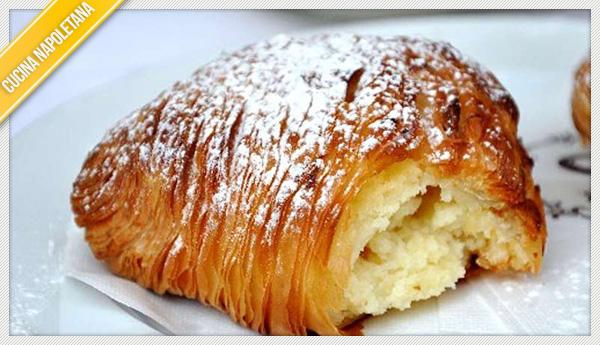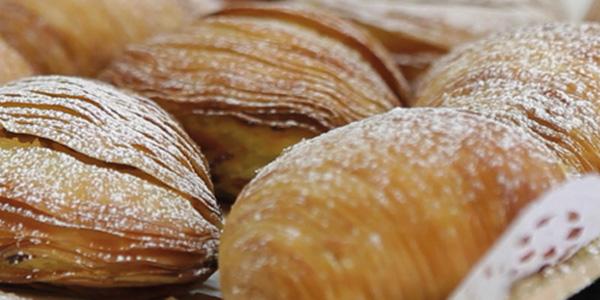
Do you want to discover the recipe of Sfogliatella Riccia napoletana? Here's how you can prepare this dessert that is part of the culinary events of the city now for more than 400 years!
Le sfogliatelle Ricce they are one of the masterpieces of Neapolitan pastry art, along with the sfogliatelle Frolle.
Their origin, like that of many other Neapolitan recipes, is accompanied by one historical tradition linked to his birth and then to its diffusion.
But before we discover the whole story, let's see how they prepare! Remembering that the preparation of the curly sfogliatella requires a certain amount practicality. in the kitchen, therefore, those who try their hand must be well aware of the difficulty and the patience that this recipe requires.
Ingredients
- For the dough:
- 500 grams of flour
- Strutto qb (just the 250 packaging will be enough)
- 200 grams of water
- 1 pinch of salt
- 15 gr of honey
For the filling
- 125 gr semolina
- 125 g fresh ricotta
- powdered sugar to taste
- 1 medium egg
- 350 grams of water
- 50 gr of mixed candies
- 1 vial of vanilla essence
- 1 pinch of cinnamon
- 1 pinch of salt
Method
Arrange the flour on a pastry board. In the middle place the melted honey, a pinch of salt dissolved previously in hot water that you will gradually pour into the flour. work well the dough, but leaving it still raw. Leave rest half an hour and then work it making it smooth and homogeneous. Brush it with lard and let it rest for about an hour.
Roll it out with the rolling pin obtaining a strip that is as long and thin as possible. To help you with the processing, never use flour, but the lard that you have to spread the whole surface of the dough.
Roll it up on itself as narrow as possible. You will have to get one roll with a diameter of about 6 cm and along a 25 cm. Grease the lard again, wrap it in plastic wrap and refrigerate.
The next day, go to the preparation of the stuffing.
In a sifted container the flour, add the sugar, the candied fruit, the medium egg, the essence of vanilla and the pinch of cinnamon.
Sul The fire place water and salt. Bring to a boil and add the semolina little by little. Cook for a few minutes, then let it cool. Once cold, add the ricotta and candied fruit and mix the two compounds.
Remove the roll from the fridge, remove the film, and cut it into slices of 1 cm each.
Each slice you will have to grease it with lard and work it with your hands (taking care not to "break" the various layers) and make some bell shapes turning the slice between the fingers and leaving the cut outwards, giving the typical conical shape of the sfogliatella.
Once the slices have been completed, fill them and bring the edges of the dough closer together without closing them.
Arrange them on a baking sheet lined with parchment paper and cook them in forno preheated to 180 ° for about 20 minutes (or as long as the surface is not golden).
Remove from the oven and sprinkle with powdered sugar.
Good curly sfogliatella!

Origin of the curly sfogliatella
The origin of the curly sfogliatelle is to be placed in the monastic environments and conventuals of Naples in the 1600s. At that time there were many convents and monasteries interested in the artisanal production of gastronomic products and, specifically, the birth of curly sfogliatelle dates back to the invention of a convent located in the historic center of the city.
The recipe was still very simple, but so special that it was secretly communicated to other Campani convents. It will, however, only in a convent of the Amalfi coast where the recipe of the curly sfogliatelle was enriched with the use of the famous and delicious ricotta of Agerola for the stuffing.
In addition at the end of the preparation the sfogliatelle were decorated with cream and sour cherries. It would seem, therefore, that a novice of the convent communicated the recipe to an amalfi pastry chef who did not hesitate to reproduce it. This brings, in a short time and fortunately, to a spread like wildfire of the production of curly sfogliatelle outside the monastic and conventual environments in the Campania region.
The young pastry chef eliminated the addition of cream and sour cherries brought in convent of Amalfi giving the curly sfogliatelle the appearance and the flavor they still have today.
It would seem that the pastry chef is to be identified in Pintauro, the illustrious pastry chef of via Toledo known for the famous phrase "Hold 'to Pintauro crowd!". According to others, however, it was not Pintauro who first became aware of the recipe, but had "only" the merit of having spread this goodness among the Neapolitans.




